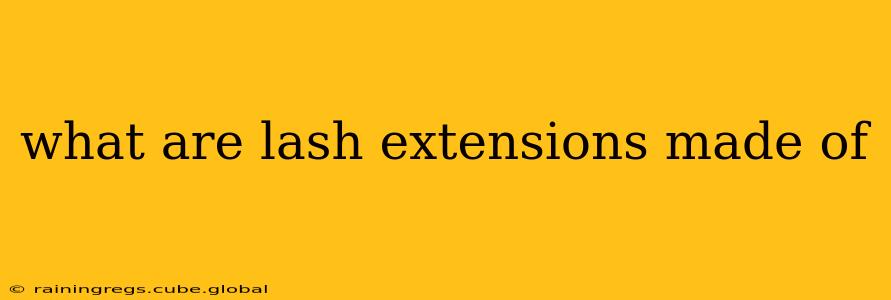Lash extensions have become incredibly popular, offering a convenient way to achieve a fuller, longer lash look without the daily hassle of mascara. But what exactly are these seemingly magical strands made of? Understanding the materials used in lash extensions is crucial for making informed choices about your treatment and ensuring the health of your natural lashes. This guide will delve into the composition of lash extensions, addressing common questions and concerns.
What are lash extensions primarily made of?
The vast majority of lash extensions on the market are made from synthetic materials, primarily PBT (polybutylene terephthalate). PBT is a thermoplastic polyester known for its durability, flexibility, and resilience. This makes it an ideal material for creating lash extensions that can withstand daily wear and tear, while maintaining their curl and shape. High-quality PBT fibers are also designed to be lightweight and soft, minimizing discomfort and potential damage to your natural lashes.
Are there different types of lash extension materials?
While PBT is the most common material, there are some variations and alternative materials to consider. Some manufacturers use slightly different blends of synthetic polymers to achieve different textures, thicknesses, or curls. The quality of the PBT itself can also vary significantly, impacting the longevity, softness, and overall appearance of the extensions.
Furthermore, while less common, some extensions are made from silk or mink. These materials often come with a higher price tag, and their characteristics – softness, sheen – contribute to their appeal. However, it's crucial to note that true mink lashes are ethically questionable due to animal welfare concerns. Many so-called "mink" lashes are actually high-quality synthetic fibers designed to mimic the appearance of mink.
Are lash extensions safe?
The safety of lash extensions largely depends on the quality of the materials used, the skill of the lash technician, and proper aftercare. High-quality PBT extensions, applied correctly by a trained professional, are generally considered safe. However, using low-quality materials or improper application techniques can lead to irritation, damage to natural lashes, or even infections.
What are lash extension adhesives made of?
The adhesive used to bond lash extensions to your natural lashes is a crucial component. Most adhesives are cyanoacrylate-based, meaning they contain a type of superglue. This ensures a strong, long-lasting bond. However, different adhesives vary in their formulation, influencing factors like drying time, longevity, and potential for irritation. It's important to choose a lash technician who uses high-quality, hypoallergenic adhesives to minimize the risk of allergic reactions.
How long do lash extensions last?
The longevity of lash extensions depends on several factors, including the quality of the materials, the application technique, and your natural lash cycle. Generally, lash extensions can last for several weeks, typically 2-4 weeks, before requiring refills to maintain their fullness and appearance. Your natural lashes shed throughout their growth cycle, and when a natural lash sheds, the extension attached to it falls out as well.
Can I use certain products with lash extensions?
Certain products can affect the lifespan and appearance of your lash extensions, so it's crucial to use appropriate products. Avoid using oil-based makeup removers, cleansers, or skincare products as these can break down the adhesive bond and cause premature shedding of the extensions.
Are there different curls and thicknesses of lash extensions?
Yes, lash extensions come in a wide variety of curls and thicknesses to cater to individual preferences and lash types. The curl refers to the shape of the lash, ranging from a natural J curl to a more dramatic C or D curl. Thickness is measured in millimeters, with different thicknesses available to create varying levels of volume and fullness. A skilled lash technician will help you choose the best curl and thickness to complement your natural lashes and desired look.
This comprehensive guide provides a clearer understanding of lash extension materials and associated factors. Remember, choosing a reputable and experienced lash technician is crucial for achieving safe and beautiful results. Always inquire about the materials used before your appointment to ensure you're comfortable with the products being used.
